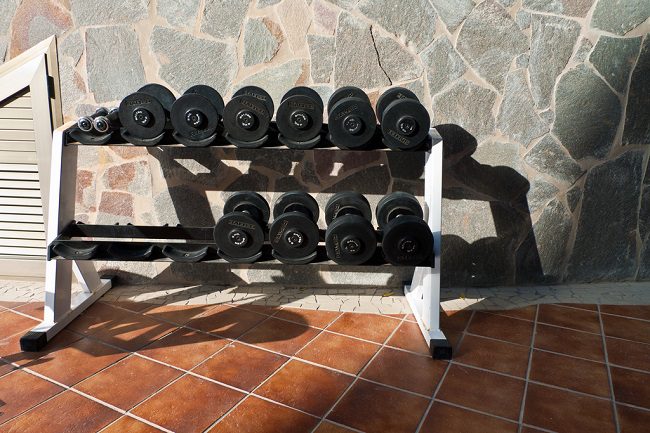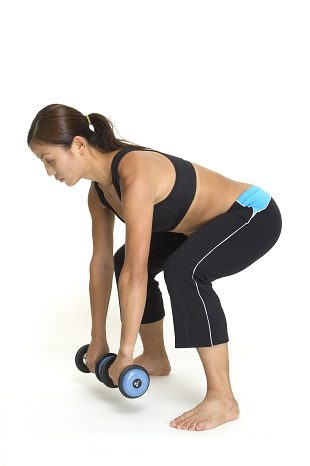Weight training: Forget the tires this winter and pump up your body
Most cyclists would rather look like Ryder Hesjedal than Arnold Schwarzenegger, so they’re often afraid to mix weights into their training program.

by Jon-Erik Kawamoto

This story originally appeared in our February/March 2011 issue.
Most cyclists would rather look like Ryder Hesjedal than Arnold Schwarzenegger, so they’re often afraid to mix weights into their training program. Many endurance athletes fear that resistance training will lead to unwanted mass, which would negatively affect their performance. These fears are understandable, but with proper program design and exercises you won’t put on extra bulk.
The Common Myth
It’s commonly believed that endurance athletes must train with light weights, high repetitions and short breaks. This is false and actually a recipe for muscle hypertrophy, exactly what cyclists don’t want. To make things simple, we’ll call resistance training for cyclists maximal strength training, which implies heavy loads, low reps and long rest periods – exactly how an endurance athlete should weight train.
The Research
Strength training has been shown to reduce injury risk and correct muscle imbalances. It has also been shown, more recently, that cyclists can improve their ‘cycling economy’ after supplementing their endurance training with maximal strength training. Cycling economy refers to the amount of oxygen required to maintain a certain power output, which is one of three components that contributes to endurance race performance (the other two being VO2 max and lactate threshold). Findings from other studies have shown the benefits also include increased work efficiency, time to exhaustion and power output. And as for the belief that strength training results in more body mass? Rather than increasing muscle size, the repetition/set scheme explained earlier resulted in neuromuscular adaptations, meaning the brain communicates better with the muscles, resulting in enhanced motor unit recruitment and rate of force development.
Program Design
Cyclists can benefit from maximal strength training one to three times per week depending on the current season and time of year. The program should focus on improving strength and power output and consist of free weight and body weight exercises, which is better for cyclists than using machines. Focus on multi-joint movements and avoid isolation-type exercises.
Sets of up to five repetitions with three-minute breaks will develop strength with minimal hypertrophy. Do not go for ‘the burn’ or to failure. Feel strong and in control at the end of every set. After your warm-up, start with explosive exercises first, followed by multi-joint exercises. Research has shown that replacing an endurance training session with a maximal strength training workout is more effective than adding the strength training sessions without adjusting endurance training volume. The latter is believed to reduce recovery time and induce unwanted fatigue. Strength train on easy days and separate your endurance training session from your strength-training workout by six to eight hours if doing two workouts per day.
Jon-Erik Kawamoto is a strength and conditioning specialist in Burnaby, B.C.
SAMPLE EXERCISES
POWER FOCUS – SINGLE ARM DUMBBELL SNATCH
Why: To develop full-body power. This exercise is easier to learn than the barbell version.
Set-up: Stand with your feet slightly wider than shoulder width apart with a dumbbell in between your feet. Squat down by pulling your hips back and down. Hold the dumbbell with a straight arm, with your elbow pointing out, chest up and most of your weight on your heels.
Performance: Take a breath into your belly to help with spine stabilization and crush grip the handle. Lift the dumbbell off the ground and over your head with the hips and knees slightly bent. The path of the dumbbell is straight along your body. Stand erect and pinch your gluteals to finish the lift. Feel like you are ripping the dumbbell out of the ground and throwing it toward the ceiling. Carefully place the dumbbell back between your feet. Perform four sets of four repetitions per side with three-minute breaks between sets.
STRENGTH FOCUS – DEADLIFT


Why: One of the best posterior chain (hamstrings and gluteals) exercises that also strengthens forearms/grip strength, core stabilizers, latissimus dorsi muscles, quadriceps and the lower, middle and upper back. Increased strength in the posterior chain will improve cycling performance. In addition, the increased strength in the core stabilizers and back muscles will counteract the aerodynamic position assumed when cycling and improve posture.
Set-up: Stand in front of a barbell or dumbells (as shown) with your shins almost touching the bar with your feet hip width apart. Sit your hips back and down and bend your knees as you grab the bar with your hands just on the outside of your stance. Your arms should remain straight with your shoulders above the bar. Your spine should be straight, but don’t confuse straight with vertical: you will be hinging from your hips. Never deadlift with a rounded back. Keep your chest up by tightening your upper back and look forward.
Performance: Take a breath into your belly and crush grip the bar. Drive your heels into the ground to stand you up. Simultaneously straighten out your hips and knees. Once you are standing tall, squeeze your gluteals hard with your chest up and shoulders down. Exhale slightly. Reverse the movement to lower the bar and place it back on the floor. Take another breath and re-grip before performing the next repetition. Perform four sets of four repetitions with three minute breaks.
